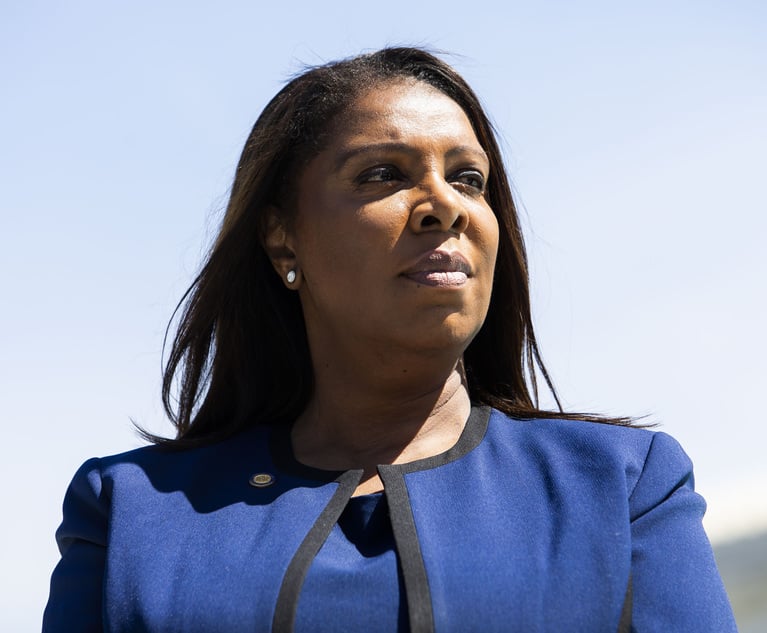In-House Compliance Counsel Leading Push for More Guidance From Regulators
A new report from the New York City Bar Association on the increased number of enforcement actions against individual chief compliance officers was sparked by the growing concerns of in-house counsel.
February 10, 2020 at 04:59 PM
4 minute read
The original version of this story was published on Corporate Counsel
 Patrick T. Campbell, a partner with Baker & Hostetler. Courtesy photo
Patrick T. Campbell, a partner with Baker & Hostetler. Courtesy photo
A new report from the New York City Bar Association on the increased number of enforcement actions against individual chief compliance officers was sparked by the growing concerns of in-house counsel.
The report, "Chief Compliance Officer Liability in the Financial Sector," is a product of the bar's compliance committee. Patrick Campbell, chair of the committee, said while he is an outside counsel, most of the committee is made up of in-house lawyers who seek more guidance and communication from regulators.
"The committee is in a unique situation to raise these issues," Campbell told Corporate Counsel on Monday. "It expresses the concerns of the compliance industry, spoken by a bar committee that is representative of the industry," and in a city that is the finance capital of the country.
Campbell, who spoke on behalf of the committee, is a partner in the New York office of Baker & Hostetler where he focuses on white-collar defense and compliance.
The report was the brainchild of Adam Felsenthal, bar committee secretary and deputy chief compliance officer and counsel at Great Point Partners, a Greenwich, Connecticut-based private investment firm. Felsenthal referred questions to Campbell.
The 28-page report comes at a time when more regulators are holding compliance officers accountable when their companies misbehave. There seems to be a growing "risk of liability arising out of an assessment made in hindsight regarding what a compliance officer or program ought to have detected and prevented," the report states.
It acknowledges that federal agencies have made some efforts toward clarifying enforcement decisions, but "the compliance community would certainly benefit from additional regulatory guidance directing compliance officers on how they may make the best of a bad situation and attempt to address compliance failures without increasing the risk of personal liability for good faith performance of their duties," the report says.
The paper consists of three parts: unnecessary risks that undermine the compliance function and regulatory goals; recent enforcement trends against compliance officers by several federal agencies; and recommendations that primarily deal with better guidance and communications.
Campbell said the recommendations "are practical, and are supported by instances of what other law enforcement agencies do" to benefit not only compliance officers, but investors and regulators as well. They do not require "heavy lifting" or major legislative changes to implement, he added.
The four key recommendations to regulators are:
- Issue formal written guidance on the principles used to determine whether or not to pursue regulatory action against compliance officers. The report suggests asking questions such as, "Did the compliance officers act willfully or recklessly?" and "Did they voluntarily disclose the misconduct and cooperate with investigations?"
- Provide updated or additional guidance through existing regulatory communications, such as risk alerts, enforcement actions and reports of examination activities.
- Create new platforms for informal communication with compliance officers, such as the roundtables sometimes used by the U.S. Securities and Exchange Commission or the LabCFTC program, in which the U.S. Commodity Futures Trading Commission established a dedicated point of contact for fintech innovators to communicate with that agency.
- Create compliance advisory groups made up of representatives from federal agencies, compliance officers for financial institutions and compliance professional associations to meet periodically to discuss concerns.
"Compliance officers can function as effective gatekeepers," the report concludes, "only if they are given the information and tools necessary to carefully police the boundary between culpable and permissible conduct—and do so without bearing a disproportionate risk of liability for others' misconduct."
This content has been archived. It is available through our partners, LexisNexis® and Bloomberg Law.
To view this content, please continue to their sites.
Not a Lexis Subscriber?
Subscribe Now
Not a Bloomberg Law Subscriber?
Subscribe Now
NOT FOR REPRINT
© 2025 ALM Global, LLC, All Rights Reserved. Request academic re-use from www.copyright.com. All other uses, submit a request to [email protected]. For more information visit Asset & Logo Licensing.
You Might Like
View All

NY AG James Targets Crypto Fraud Which Allegedly Ensnared Victims With Fake Jobs
4 minute read
CFPB Alleges Berkshire Hathaway Subsidiary Originated Unaffordable Housing Loans

Class Certification, Cash-Sweep Cases Among Securities Litigation Trends to Watch in 2025
6 minute readTrending Stories
Who Got The Work
J. Brugh Lower of Gibbons has entered an appearance for industrial equipment supplier Devco Corporation in a pending trademark infringement lawsuit. The suit, accusing the defendant of selling knock-off Graco products, was filed Dec. 18 in New Jersey District Court by Rivkin Radler on behalf of Graco Inc. and Graco Minnesota. The case, assigned to U.S. District Judge Zahid N. Quraishi, is 3:24-cv-11294, Graco Inc. et al v. Devco Corporation.
Who Got The Work
Rebecca Maller-Stein and Kent A. Yalowitz of Arnold & Porter Kaye Scholer have entered their appearances for Hanaco Venture Capital and its executives, Lior Prosor and David Frankel, in a pending securities lawsuit. The action, filed on Dec. 24 in New York Southern District Court by Zell, Aron & Co. on behalf of Goldeneye Advisors, accuses the defendants of negligently and fraudulently managing the plaintiff's $1 million investment. The case, assigned to U.S. District Judge Vernon S. Broderick, is 1:24-cv-09918, Goldeneye Advisors, LLC v. Hanaco Venture Capital, Ltd. et al.
Who Got The Work
Attorneys from A&O Shearman has stepped in as defense counsel for Toronto-Dominion Bank and other defendants in a pending securities class action. The suit, filed Dec. 11 in New York Southern District Court by Bleichmar Fonti & Auld, accuses the defendants of concealing the bank's 'pervasive' deficiencies in regards to its compliance with the Bank Secrecy Act and the quality of its anti-money laundering controls. The case, assigned to U.S. District Judge Arun Subramanian, is 1:24-cv-09445, Gonzalez v. The Toronto-Dominion Bank et al.
Who Got The Work
Crown Castle International, a Pennsylvania company providing shared communications infrastructure, has turned to Luke D. Wolf of Gordon Rees Scully Mansukhani to fend off a pending breach-of-contract lawsuit. The court action, filed Nov. 25 in Michigan Eastern District Court by Hooper Hathaway PC on behalf of The Town Residences LLC, accuses Crown Castle of failing to transfer approximately $30,000 in utility payments from T-Mobile in breach of a roof-top lease and assignment agreement. The case, assigned to U.S. District Judge Susan K. Declercq, is 2:24-cv-13131, The Town Residences LLC v. T-Mobile US, Inc. et al.
Who Got The Work
Wilfred P. Coronato and Daniel M. Schwartz of McCarter & English have stepped in as defense counsel to Electrolux Home Products Inc. in a pending product liability lawsuit. The court action, filed Nov. 26 in New York Eastern District Court by Poulos Lopiccolo PC and Nagel Rice LLP on behalf of David Stern, alleges that the defendant's refrigerators’ drawers and shelving repeatedly break and fall apart within months after purchase. The case, assigned to U.S. District Judge Joan M. Azrack, is 2:24-cv-08204, Stern v. Electrolux Home Products, Inc.
Featured Firms
Law Offices of Gary Martin Hays & Associates, P.C.
(470) 294-1674
Law Offices of Mark E. Salomone
(857) 444-6468
Smith & Hassler
(713) 739-1250








